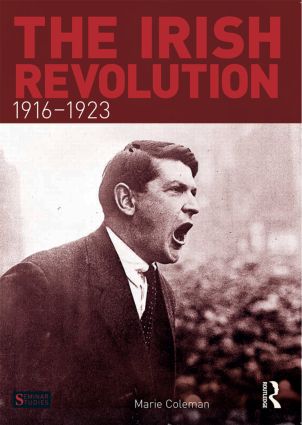The Irish Revolution 1916-1923, Marie Coleman
Routledge (imprint of Taylor & Francis Group), Abingdon and New York 2014
ISBN: 978-1-408-27910-6
Paperback, with images in black and white, maps, abbreviations, chronology, who’s who, glossary, guides to further reading, literature list and list of plates, and index
169 pages
£23,99 / €35,23 / $38,95
An introductory overview of the Irish revolutionary period
With the centenary of the Easter rising drawing near it is appropriate to give some attention not only to the events in Dublin in 1916 but to the whole revolutionary period in Ireland that began in the first years of the 1910’s and ended with the formal ending of hostilities between the pro- and anti-Treaty forces in 1923. As it turns out, Marie Coleman’s Seminar Studies volume serves as a fine overview of this intriguing but also confusing period in Irish history. Coleman lectures History at Queen’s University in Belfast and is specialized in the period known as the Irish revolution.
As every book in Routledge’s Seminar Studies series Coleman’s work contains a lot of supportive lists, glossaries and indexes to help the beginning student of the subject to understand the material most thoroughly. In addition, the volume includes a wealth of printed source material from the period under scrutiny. This allows the reader to experience for himself the so-called ‘historical sensation’, a phrase coined by famous Dutch historian Johan Huizinga in the 1920’s to describe the unique moment one can experience when studying primary sources from history.
The book deals in a very concise manner with the most important themes of what has become known as the Irish revolution in the first decades of the twentieth century. Coleman first gives an overview of the Irish Question, the campaign for self-government in Ireland, from the nineteenth century up to the 1916 rising. She then analyzes the events before, during and after the 1916 rising and the ensuing political and military campaigns for Irish independence in the years 1919-21. The Treaty with the British and the bitter civil war that followed form the final part of the study.
Thus this whole pivotal period in Irish modern history is brought into the limelight and is analyzed in a detached and scholarly manner. This makes the book very useful for anyone without much prior knowledge of the period and who has an awakening interest in it. Unfortunately, this strength of the book also means its weakness, because it doesn’t offer any new insights or analysis at all. The book is clearly meant for people who haven’t studied Irish late-nineteenth and early-twentieth Irish history at all and therefore the more experienced reader can become bored after some time, reading only things he already knew. For those however, there still remains the third section of the book containing all the primary documents that are being dealt with in the main text. Of course the text of the 1916 Proclamation of the Irish Republic and a copy of the Anglo-Irish Treaty are amongst them, but also speeches, extracts from newspaper articles and diaries, and government acts from the period can be read. For the beginning student, the book holds everything you can hope for. Alongside the main text, there are terms from the glossary explained where they appear in the monograph, an extensive chronology to keep track of the period’s events can be found at the beginning of the book and the index at the end makes quick searching for key persons or events possible.
All in all Coleman succeeded remarkably well in providing a concise and very useful student handbook on the period of the Irish revolution. It can also serve as an excellent introduction into this important time in Irish history, but for the more experienced readers the volume will contain nothing new, although the primary document section will be of interest to them also.
Wouter van Dijk

